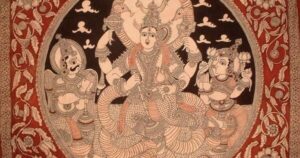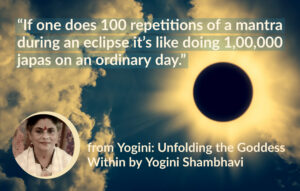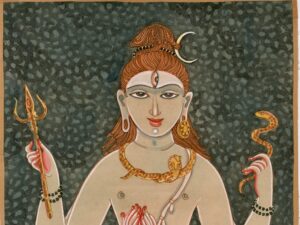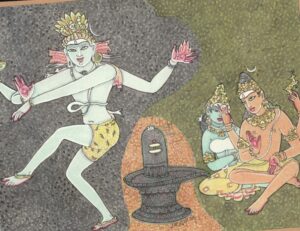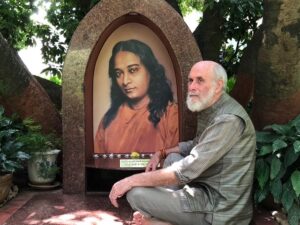Soma, the Counterpart of Agni
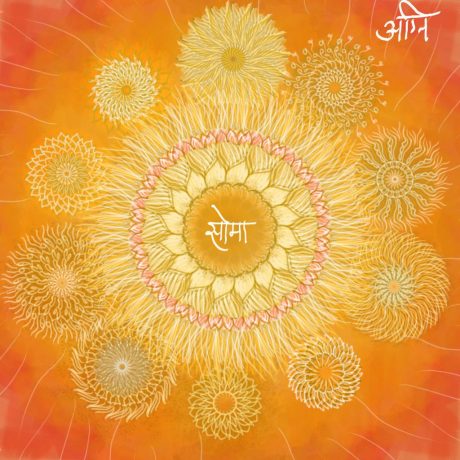 Every form of Agni has a corresponding form of Soma, without which it cannot function properly. This is also an important fact to carefully consider. Soma is the principle of water, nourishment and bliss that complements Agni as fire, purification and knowledge. Similarly, Agni is the Sun and Soma is the Moon, the active and receptive aspects or electrical and magnetic forces, and all such complementary principles in nature. The entire universe is of the nature of Agni and Soma.
Every form of Agni has a corresponding form of Soma, without which it cannot function properly. This is also an important fact to carefully consider. Soma is the principle of water, nourishment and bliss that complements Agni as fire, purification and knowledge. Similarly, Agni is the Sun and Soma is the Moon, the active and receptive aspects or electrical and magnetic forces, and all such complementary principles in nature. The entire universe is of the nature of Agni and Soma.
Agni is the primary principle in Vedic knowledge. This begins with the centrality of the digestive fire in Ayurveda. It extends to the fire of prana and to the fire of meditation, which are the basis of higher Yoga practices.
Agni in the broader sense is a cosmic power of light, perception and transformation, extending to the light of consciousness itself. Agni is not merely fire as a material or physical principle but as the light of all existence, with the entire universe itself existing as the cosmic fire.
In Ayurvedic treatment and Yoga practices, Agni relates to light, heat, purification and detoxification. It is the application of heat in some form or another that purifies, ripens, cooks and transforms. Higher Agnis are needed to develop a higher awareness.
On an outer level Soma is the fuel for the fire as Agni. Yet on an inner level Soma is the transformed essence prepared, cooked or ripened for the fire – the fruit of Agni’s activity.
- For the digestive fire, good natural food is its fuel based Soma. Yet healthy tissues of the body are the Soma or result of the digestion of that food.
- For the Pranic Agni or life fire, good air, space, environment and positive fragrances are its fuel based Soma. A positive loving emotional expression is the inner Soma that is the result of proper development of prana.
- For the mental Agni, good natural sensory impressions are its outer Soma or fuel. Creative intelligence is the inner Soma that is the result of proper digestion of our sensory impressions.
- At the highest level for Agni as consciousness, there is the complimentary Soma as Ananda or bliss. This is the Soma of higher Vedic knowledge and the Ananda of Vedantic meditation.
The Importance of Soma in Your Meditation Practice
Soma is a Sanskrit term that derives from the root su, meaning to “energize, stimulate, swell, expand and grow.” It refers to the power of bliss or ananda, which in Vedic thought is the origin of all things and the basis of all creation.
Soma is first described in the Soma hymns of the Rigveda, the oldest Vedic text, which predominate in the ninth book or mandala. They are regarded as the most important hymns in the entire text and as providing the power to make us into Rishis or seers.
If we consider the role of Soma in our healing and spiritual practices, as well as Agni, we can create a more integral and balanced approach. We can learn how to enhance the bliss or Samadhi that is also the highest goal of our efforts.
To contact this Soma principle, we must first love what we are doing and have a genuine interest in our practice and our teaching. We must be guided by inspiration and aspiration, seeking both to grow in our own being and share what we learn respectfully with others.
Soma can be contacted initially as the well-being that you feel from your practice. It is the satisfaction that you gain through doing it on a regular basis. In regular practice there is a certain samskara or tendency to continue and expand it, a habit you get into, not based upon compulsion but based upon following the rhythms of life. It is like cultivating a garden and enjoying the plants grow, flower and produce fruit.
Soma, the Mind and Brain
Soma is called “nectar” or amrita. As amrita means both nectar and immortality, Soma is also called the “nectar of immortality.” Soma flows in drops called bindus in Tantric thought.
As Agni is the fire that ascends from below, Soma is the grace that descends from above. Agni relates to the Kundalini fire that ascends from the root chakra below and Soma is the corresponding nectar that descends from the thousand-petal lotus of the head above in higher Yoga practices. The thousand-petal lotus is often called the seat of Soma or the Moon.
Soma relates to the mind in Vedic thought, which is often identified with the Moon, and has its seat in the head. The mind like the Moon has a reflective nature that is developed through receptivity, observation and contemplation. The mind functions best when it is cool and calm like the light of the Moon. The mind has its own natural contentment when it rests in its own nature, held silent within us. Honoring the Moon in our lives and understanding the place of the Moon in our Vedic astrology chart helps us work with the Soma within us.
The thousand-petal lotus of the head has its physical counterpart in the brain and its many folds of tissues and fluids. In terms of Ayurveda, Soma relates to the Tarpak Kapha, the one of the five forms of Kapha dosha that lubricates and nourishes the brain and nervous system. It supports the watery nature of the cerebrospinal fluid, and promotes contentment, harmony and well being at both physical and psychological levels. Tarpak means, “that which gives contentment.”
Developing Tarpak Kapha, amrit or Soma is a way of gaining control of our own brain chemistry and promoting the secretion of positive chemicals and hormones that keep our nervous system calm and content. This development of Soma/Tarpak Kapha can help counter many adverse psychological conditions notably depression, anxiety, stress, anger and addictions of all types. It is an important factor in Ayurvedic psychological treatments.
This inner Soma or Tarpak Kapha has the power to heal and rejuvenate both body and mind, including the senses and the nervous system. It is the basis of Ayurvedic rejuvenation therapies, particularly for the mind.
Soma and Mantra
Mantra is the main yogic tool for working on the mind. This implies the development of Soma, amrit or Ananda as the essence of the mind. Mantra can be used to develop our inner Soma, which is the bliss and happiness inherent in the nature of awareness. As you develop the Soma or bliss energy of your mantra, it will have a greater healing power both for yourself and for others.
Yet as a form of Soma, the mind is also the ultimate result of our nutrition and digestion at both physical and psychological levels. This essence of mental digestion is reflected in our memories. The mind as the essence of our memory should be based upon positive memories and attitudes. Taking your mantra to the deepest level of your memory is an important way to do this.
Meditation is a way of cultivating the essence of our being and connecting to the inner delight or Soma of resting in our own nature as pure awareness. It is a way of extracting the essence of peace and bliss that pervades this vast wonderful universe of consciousness. The seed mantra develops into a natural state of meditation in which we can feel a single awareness, vibration and creative energy pervading not only ourselves but also the entire world around us.
Unitary Mind, Prana and Speech
Concentration is the foundation for developing meditation. The rule is that when the mind becomes one-pointed (what is called the ekagra chitta in Yoga and Vedanta) then it naturally moves into a state of meditation and samadhi – its bliss or Soma begins to naturally flow.
This means that we need to bring our minds into a state of singularity, like a singularity as in modern physics that moves beyond the ordinary laws of nature, in order for any inner transformation to occur. In a singular state, the mind is able to move beyond time, space and karma, beyond localized awareness to unitary consciousness that connects us with the entire universe. This single pointed awareness is the bindu or point focus that is also the drop and flow of Soma.
A seed mantra is an important way to develop this one-pointed mind. The practice of Self-inquiry in Vedanta, or asking the question “Who am I?” is another. The one-pointed mind is the unitary mind in which we are wholeheartedly attentive to whatever concerns us in life.
This unitary mind in turn is linked to the unitary prana, which is the concentration not only of the breath, but the energization of our entire vitality towards a higher goal in life.
Additional Tools for Practice
For proper meditation it is often recommended to keep the mind cool, calm, tranquil and composed like a still mountain lake that can reflect the deep blue of the boundless sky. Keeping the head cool and the belly or navel warm is a key to balancing and supporting Agni and Soma.
There are a few practical things that you can do in this regard. One is to place the tongue at the roof of the mouth, which aids in the upper movement of awareness and delight. It helps draw the prana and speech upwards and move our consciousness into space.
Another is to focus your mind at the point of the soft palate at the top back of the root of the throat. There is a special smaller mind chakra here that controls all the five senses and allows the nectar of higher awareness to flow down through the brain. It is the Soma or watery counterpart of the third Eye that has a fiery or Agni nature.
From the soft palate of the mouth one can experience a flow of nectar from the brain that will bring a sweet taste to the saliva. Fixing our awareness at this point also helps us control all the senses and turn them within. This is aided by holding our inner gaze at this location.
Effortlessness and Flow
The Soma of delight flows best when we give up outer effort and enter into an effortless state of both inner and outer relaxation, which is to open our hearts to the grace and beneficence of the magical universe in which we live. We need to learn how to flow with the grace and delight of all existence. Often our personal efforts, strain and striving inhibit us in our higher growth and spiritual evolution. Our practices should be done naturally and gently, allowing inner processes to unfold, like a stream moving to the sea.
Space
To develop this nectar of meditation, we need to create a sense of space and vastness in our awareness. Space is delight or ananda, as it is freedom and letting go of all bondage. Vastness in the mind is necessary to create space – meaning that we must let go of little and trivial things, personal and emotional conflicts, and connect ourselves with the unbounded universe and its innumerable forms of life and consciousness.
Contentment
Another key to meditation and yoga practice is contentment or santosha, one of the five niyamas or foundational principles of Yoga practice that is seldom given its proper role. Cultivate contentment of an inner type, recognizing the bliss inherent your own being. This is not to give into inertia and try to accommodate or excuse for our weaknesses in life. It is to affirm that in our inner nature we are perfectly happy, free, aware and immortal, one with all. This attitude of bliss or Soma bhava will allow negativity to fall away from us naturally.
Receptivity
Another important Soma principle is receptivity. Be receptive, which means to be respectfully observant of all life, of yourself and of all your relationships. When we are quietly receptive then what is of greater value and truth will naturally come to us. This involves becoming a vessel in life that is open to and can carry the nectar, grace, beauty or Ananda that pervades all things. To be receptive means not to judge but to allow each thing to reveal and unfold its true nature for you.
The Play of Delight
Soma also relates to the play or lila of life. Life should be a play of delight or ananda. But for that to occur we must seek to unfold our own inner bliss. We should seek to bring happiness into the world rather than to pursue happiness from external objects or from other people, which only means that we do not have adequate happiness inside ourselves. Learn your role in the Divine play and enter into the dance of creative intelligence.
Conclusion
We live in an age in which we have many new forms of entertainment and enjoyment, through our ever-developing media and information technology. These have many benefits but also can breed addictions for us, in which we may get caught in external stimulation and forget to look within to find our own innate happiness.
We should not confine our awareness to an outer screen or a cell phone but should learn to direct it to the point of universal communication and bliss, which is the point focus of our own hearts.
The true seeking of bliss and pursuit of happiness in life is not something external. It is an inner search for the core divine awareness within our own minds and hearts that is also the ground of all existence. Our meditation should involve that inner search for Soma, bliss and happiness within. Our entire life-style should support this, integrating Yoga, Ayurveda and Meditation into a complete system of well-being that takes us to the supreme bliss or Ananda.
Dr. David Frawley
Note the author’s books Soma in Yoga and Ayurveda: The Power of Rejuvenation and Immortality, and Mantra Yoga and Primal Sound for further information on these topics.

